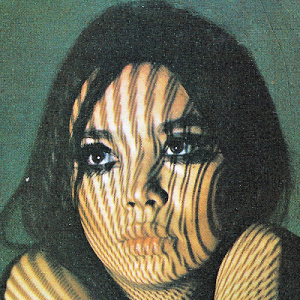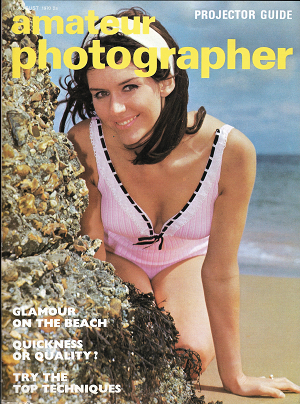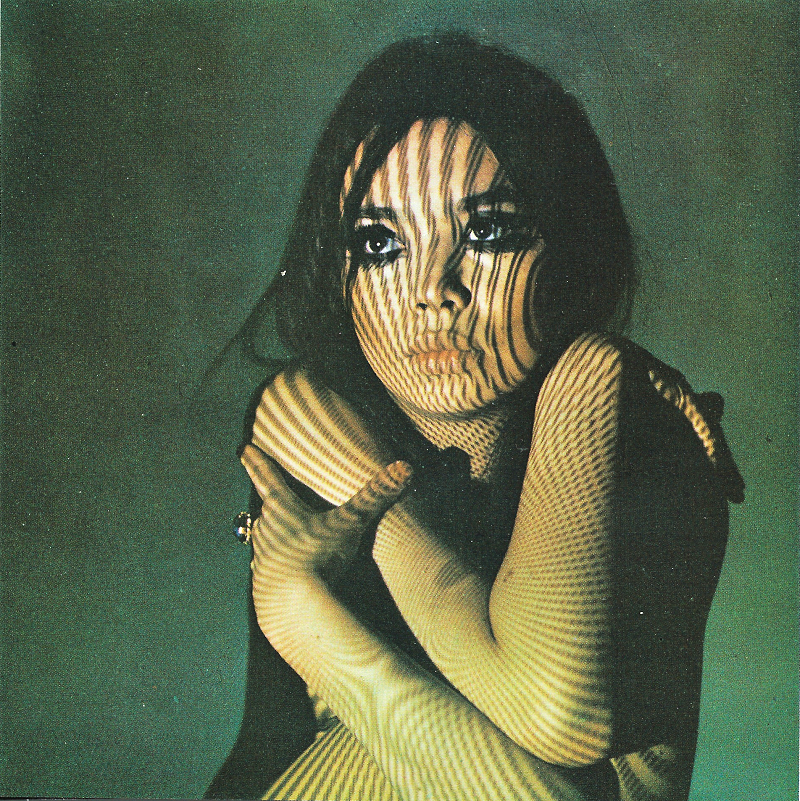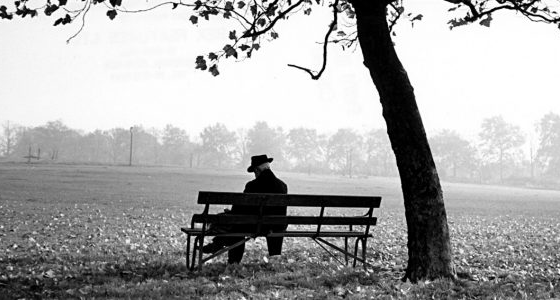A Tale of Two Henriettas
This is a follow-up article to Paint
Your Wagon: Iggy movie unearthed!
To watch the BFI movie: Hippies
St Germans (geoblocked outside Great Britain).
To watch some
excerpts on the Felix Atagong YouTube channel: Iggy
at Port Eliot (1968).


Zeliggy
A talented journalist will write great lines. Mark Blake was spot on when he described Iggy the Eskimo as a Zelig-like presence on the capital's music scene of the mid-sixties.
For those who aren't familiar with 20th century symbolism, Zelig is a 1983 bittersweet satire, from Woody Allen, about a somewhat colourless man who inexplicably appears on cinema newsreels of the twenties and thirties (the nineteen-hundred twenties and thirties, obviously).
The same goes for Iggy although ‘colourless’ is about the last adjective we think of to describe her. The Brighton Mod & Rockers War: Iggy was there. Hendrix’s first concert in London: Iggy was there, sitting on the stage. The Sympathy For The Devil sessions: Iggy was there, but she is nowhere to be found in the Jean-Luc Godard movie. Performance: Iggy was there, refusing a role as an extra. Pictures of her ‘backstage’ still have to emerge and if we may believe her own words there must have been photographic evidence with Eric Clapton, Roger Daltrey, George Harrison, Brian Jones, Anita Pallenberg, 'Keef' Richards and 'lovely' Keith Moon...
Iggy’s most Zelig-like presence is on a picture taken by Bruce Fleming on a party on the 8th of January 1967, attended by three different Beatles. Carmen Jimenez was Georgie Fame’s girlfriend and for her 21st birthday a fancy dress event was organised at The Cromwellian. The picture has Carmen playing peek-a-boo behind John Lennon, who is dressed like a priest, but at the right hand side of the picture a glimpse of Iggy can be spotted.
And, my dear sistren and brethren, let us not forget, she was one of the first persons to listen to the early tapes of The Madcap Laughs. She was there, with Syd Barrett, Zelig-like, seamlessly blending in the background, while Storm Thorgerson and Mick Rock took their legendary pictures.
Unfortunately another rock star, probably Steve Peregrin Took (or Tookie, as Iggy used to say) from Tyrannosaurus Rex fame, tossed her suitcase overboard containing most of her pictures when crossing the Channel, heading for (or returning from) Spain. Iggy’s relationships have always been somewhat tumultuous and she went through some rough times with some less disciplined rockers.
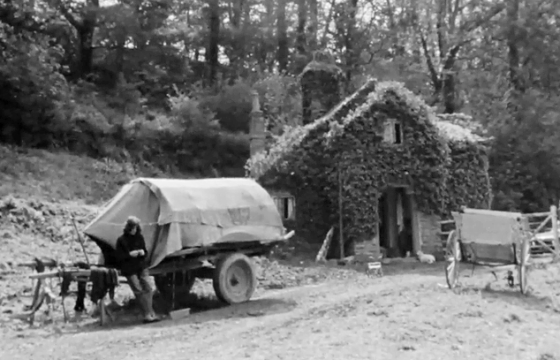

Henrietta Moraes
In a previous article (Paint Your Wagon) we wrote how Iggy joined a bunch of aristocratic would-be hippies who were looking for the Holy Grail, travelling in a horse-drawn wagon, following ley lines and UFO sightings all over Devon and Wales. They were caught in a documentary at the Port Eliot castle, where they could stay from Peregrine Eliot, 10th Earl of St Germans.
Iggy told the Church that the notorious junkie muse Henrietta Moraes was one of the people joining the Port Eliot convoy. In 1968 she was already 37 years old, Iggy only 21, but she was still an underground society figure to be reckoned with.
Perhaps they felt they had something in common. Henrietta (real name: Audrey Wendy Abbott) was born in India – just like Iggy – and their fathers had been military men. Moraes’ had been a free spirit in the fifties, roaming through the Soho subculture and being a model for Lucian Freud and Francis Bacon.
When the Sixties hit the streets Henrietta traded Soho for the psychedelic underground, taking every drug imaginable and continuing her eccentric and promiscuous lifestyle.
Henrietta Moraes can not be seen in the Port Eliot documentary, but in her autobiography Henrietta, that appeared in 1994, she describes her life on the road with Mark Palmer. There isn’t a single trace of Iggy in that book, which seems weird at first, but there could be a logical explanation.
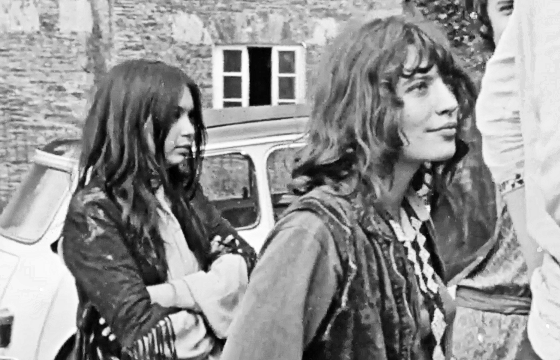

Henrietta Garnett
Recently a new person was identified on the Port Eliot film. One of the horse carriage hippies is Henrietta Garnett, an acclaimed author who published several biographies and a novel.
Henrietta Garnett (1945 – 2019) was a third generation member of the Bloomsbury Group, a loose assembly of artists, intellectuals, philosophers and writers, including Virginia Woolf, John Maynard Keynes and E.M. Forster. Her father, David Garnett, was an author and publisher. Her mother Angelica was a writer, painter and artist.
It has been said from the Bloomsbury’s that ‘they were living in squares, painting in circles and loving in triangles’.
Henrietta’s mother – for instance – Angelica Bell, was not the daughter of her legal father, but the product of some extramarital gymnastics with painter Duncan Grant. Her father was a bi-sexual serial libertine, who once had a gay fling with that same man.
At 17 a pregnant Henrietta married Lytton Burgo Partridge, author of A History of Orgies, but she was almost immediately widowed when he died three weeks after the birth of their daughter.
Henrietta, obviously shocked, opted out raising her daughter and fled into the London underground, living the gypsy life and enjoying the swinging sixties at full extent. Five years later, in 1968, she joined the band of aristocratic dropouts who visited Port Eliot, together with Iggy the Eskimo.
Although she followed the travelling aristos, she wasn’t really impressed with them, calling them ‘chequebook hippies’. Something she had in common with Iggy, who only found out later that the people she had joined were hippie millionaires.
But not all travellers were as we will now see in a not so short detour.
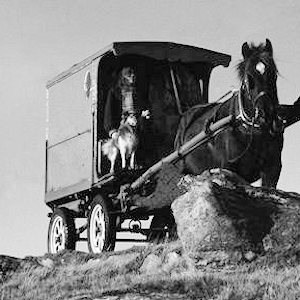
Vashti Bunyan
In Rob Young’s excellent ‘Electric Eden: Unearthing Britain’s Visionary Music’ he describes how a fifty years old Austin ran out of fuel, somewhere in 1967.
Three people (and a dog, Blue) were in the vehicle. Robert Lewis and folk musician John James started to push the vehicle, towards the next village and petrol station, while Vashti Bunyan took the steering wheel. It was then they saw an old baker’s delivery cart, belonging to a Romany, who sold them the caravan and its horse, Bess.
Vashti had already released a couple of singles, some under the guidance of Andrew Loog Oldham, but the plan to make her a second Marianne Faithfull had failed. Robert Lewis and Vashti were a couple, living the hippie life in the woods of Chislehurt, until they were evicted by the police.
The money to buy the cart was lent to them by Donovan Philips Leitch, who was some kind of a guru and benefactor of the hippie movement. With the money of his first three albums (and one compilation) Donovan had bought three Scottish islands where he wanted to set up an idyllic hippie commune. That is were Vashti and her boyfriend were now heading to. Their plan was to (slowly) drive from Kent to the Scottish Highlands, along the mythical ley lines, a journey that would take them a year and a half.
The rural communities of England were not known for its hospitality towards strangers. The plan of earning some pounds by singing songs at market places and other events was often interrupted by the police, who chased them away. In several villages people were afraid that the Lewis-Bunyan couple would kidnap children or steal chickens, whatever came first. But somehow they managed to survive, often by harvesting scrap metal and selling it, and luckily there were other travellers around willing to help the couple on the road.
While the horse and carriage was parked in the Lake District, during the winter of 1968-69, Vashti made a small tour around pubs and bars in the Netherlands and Belgium. Above a bar in Ghent she met American folk player Derroll Adams, who was a friend of Donovan as well, and he encouraged her to record the songs she had written on her journey so far. She contacted Joe Boyd, who had already tried to record her when she was under contract with Andrew Loog Oldham, and plans were made for an album, although her (far from) idyllic trek through England and Scotland still came at first place.
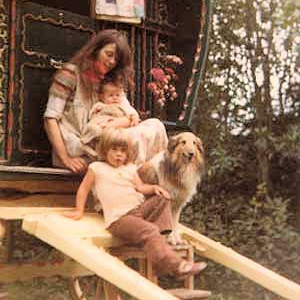
In summer 1969 they finally reached Skye, but Donovan had permanently left rainy Scotland for Los Angeles, leaving the commune on its own. Some hippies were still there, others had already left and newcomers were not encouraged to stay.
Vashti and friend settled on the island of Berneray, where they were not welcome by the local population either, with the exception of an eighty-three-year-old neighbour, who could sing old Gaelic folk songs.
Vashti finally booked some recording sessions at Sound Techniques and in November 1969 Christopher Sykes picked her (and Robert) up for the long drive to London. It took her three days to record the fourteen songs of Just Another Diamond Day. They are incredibly frail and intimate, lullabies for the unborn child she was carrying. Christopher Sykes and John James, who also painted the sleeve, helped her out. Joe Boyd added extra musicians from The Incredible String Band, Fairport Convention and Nick Drake's backing band, which was - at the time - not appreciated by Bunyan at all.
Just Another Diamond Day finally came out in December 1970, a year after it had been recorded. By then Vashti had to take care of her baby and a rock’n’roll style of life – promoting, touring and recording – was out of the question.
Settling down in Berneray had failed as well. After a brief stay in London and at the farm of The Incredible String Band the couple left for Ireland, still on a wagon and with their horse Bess.
We kept travelling by horse and wagon, which was entirely stupid. By the time we got there, of course, the price would go up beyond our reach. That kept happening. We walked across Ireland. We stayed there a year, with a bigger wagon that did have a stove in it.
Only a couple hundred Vashti Bunyan records survived (the cheapest copies sell for around £1500) and it became a cult-record in the last decade of the past century, thanks to the power of the internet and bootleg versions of the album. In 2000 the album was officially released on CD.
Since then it has been described as one of the finest British folk albums ever. Vashti Bunyan briefly re-entered the music business after a 35-years hiatus, releasing a second album in 2005.
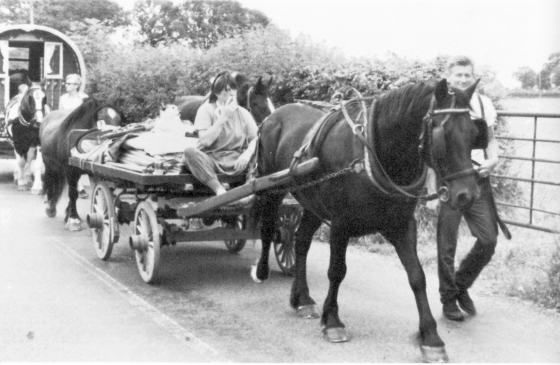
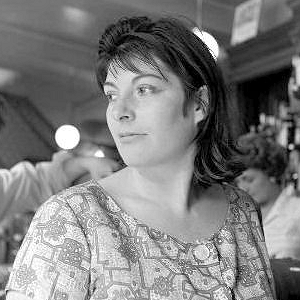
Mark Palmer’s Convoy
Henrietta Moraes, who had been a dropout in the mid-fifties, was already 35 when she tumbled in the upper-class psychedelic underground where she met Christopher Sykes, an English author, musician, BBC Radio collaborator and a friend of Vashti Bunyan. Other alternative minds of the psychedelic cultural elite were antique dealer Christopher Gibbs, interior decorator David ‘Monster’ Mlinaric, Michael Rainey & Jane (née: Ormsby-Gore), Victor & Julian Ormsby-Gore, Beatrix, Rose & Anne Lambton, Catherine Tennant and of course: Mark Palmer. It was a fairly small world, inhabited by mostly well to do people.
Mark Palmer sat in Hyde Park with Martin Wilkinson and Maldwyn Thomas. (…) An idea came. Why don’t we drop out? Why don’t we leave London and go to the country? Why don’t we buy a horse and cart and travel all over the place, all over England in fact, like gypsies and be free? So that is what they did, and they travelled down to Port Eliot in Cornwall.
Martin Wilkinson and Maldwyn Thomas were English Boy models, the company owned by Mark Palmer. Thomas was (or would be) married to Jenny Fabian one day.
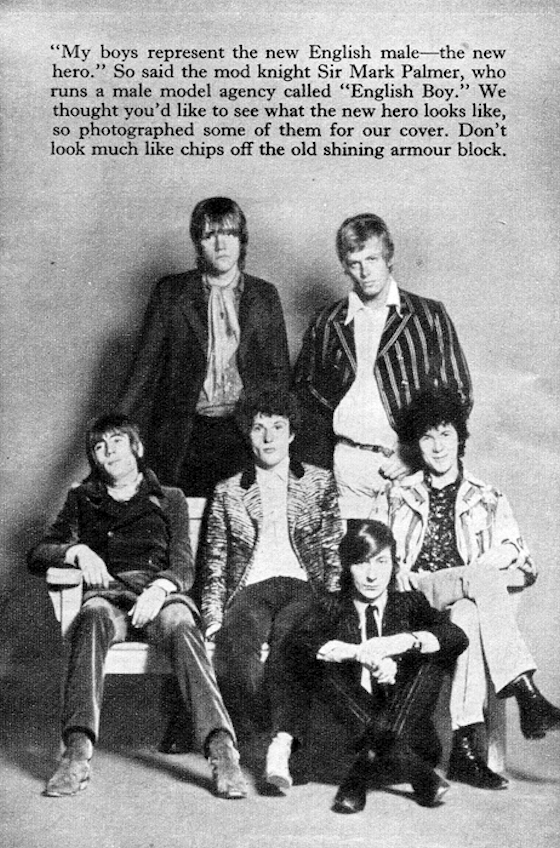
Henrietta Moraes places this event after the Rolling Stones concert in Hyde Park, on the fifth of July 1969, while the BFI claims the documentary made at Port Eliot (with Iggy and Henrietta Garnett) dates from the year before. According to Moraes a gypsy barrel-top wagon was bought, together with Rizla, a brown and white-coloured horse and Fly, a brindled lurcher dog.
Henrietta joined the band of wanderers a couple of months later, around Easter of 1970.

Dating problems.
It is practically 100% certain that Iggy was living with Syd Barrett in April 1969, so either she went on her wagon trip the year before (1968 is the date given by BFI) or the year after (1970 is the date given by Henrietta Moraes).
Probably Mark Palmer organised different treks over the years, a first one to Port Eliot with Iggy and Henrietta Garnett in 1968 and a second one with Henrietta Moraes in 1970, and that is the one that would take him 4 years to reach his destination. This explains the absence of Henrietta Moraes in the BFI documentary and the absence of Iggy (and Henrietta Garnett) in the Moraes autobiography.
The confusing thing is that Iggy claimed to have visited Port Eliot, with Henrietta Moraes, to celebrate Mayday where ‘Peregrine's beautiful ladies were sitting astride the horses that were adorned with flower garlands, dressed as dames from King Arthur's Court.’ Perhaps she mistook the one Henrietta for the other. Perhaps, as we have suggested before, she visited Port Eliot more than once.
In her memoirs Henrietta Moraes remembers riding Sagittarius, an Arab stallion, bareback as the aristo-hippie guru didn’t believe in saddles. Not believing in saddles is one thing, but Mark Palmer was also convinced that real travellers and people on the road didn’t need baths either, as he pointed out to Henrietta Moraes one day.
Maldwyn Thomas had about the same to say:
Somebody said quite innocently, “Would you like to have a bath?” and without thinking I said, “It’s alright. I had one two months ago.”
Mark Palmer may have been an aristocrat but he really was very serious about living the alternative life. On the first leg of their journey the travellers passed through Hungerford, Frome, Trecarrel Mill and Launceston, where they caused a huge stir. Henrietta Moraes:
A lot of people taught we were the circus and tried to buy tickets from us.

John Michell
Visits were made to Arthurian places like Boscastle, Camelot and Tintagel. It was at one of those they allegedly spotted a flying saucer. It only convinced them even more they were on the good path for whatever they were looking for.
One of the travellers was none other than John Michell, who was jokingly (and not so jokingly) described as the counter-culture new Merlin. He was an esotericist involved in the London Free School and had written the book 'The Flying Saucer Vision: The Holy Grail Restored'. He firmly believed that UFOs were somehow connected to ancient British myths like those of King Arthur and the Holy Grail, although (according to his critics) he could never explain exactly how.
For Michell flying saucers were not necessarily alien. They could be seen as 'emanations of the human psyche, archetypes in Jungian terms, observed at sites with ancient religious significance'. UFOs were not alien, but earthly machines - from Atlantis perhaps - intimately intertwined with forces derived from the alignment of the British landscape. There are those ley lines again! He as well, was convinced of the importance of the times they were living in:
The strange lights and other phenomena of the post-war period were portents of a radical change in human consciousness coinciding with the dawn of the Aquarian Age.
Michell witnessed strange lights in the sky, experienced new 'psychedelic' music, took a lot of LSD and was convinced that 'the world was about to flip over on its axis so that heresy would become orthodoxy and an entirely new world order would shortly be revealed'.

Psychedelic Pilgrims
According to Henrietta Moraes eight persons could travel in the horse-driven cart. But the caravan was also accompanied by cars and motorcycles, especially at the weekends when would-be hippies travelled from London to wherever the convoy was. It's not that they were moving very fast.
When they left London the band of travellers included a fine batch of (pretty well-doing) alternative thinkers and a little yellow mongrel bitch, Chloe. Moraes identifies the following beautiful people:
Derek Fitzgerald, member of London’s flower power intelligentsia and a
friend of Nick Drake.
Greg
Ridley, bass player, member of Spooky
Tooth and Humble
Pie.
John Michell, esotericist, author of ‘The Flying Saucer
Vision’ and International Times contributor.
John Pearse,
tailor and Granny
Takes A Trip collaborator.
Kelvin Webb, English Boy model agency
co-owner.
Maldwyn Thomas, English Boy model and boyfriend, later
husband, of Jenny Fabian.
Nicky Kramer (or Cramer), the Kings Road
Flower Child, a dandy dope head who was regarded by the aristos as a
penniless ‘hanger on’. (Read more about him at the Redlands
Bust blog.)
Nigel
Waymouth, designer, partner in Granny Takes a Trip and co-artist in Hapshash
and the Coloured Coat.
You have to admit the above list reads like a who-is-who of Swingin' London. On the road they met other travellers with wagons and sometimes they decided to go the same way. There was Penny Cuthberson and her coloured mare, Lily. Angus Wood, aka The Colonel, his wife Debora and a horse called Jacob joined them as well, later on.
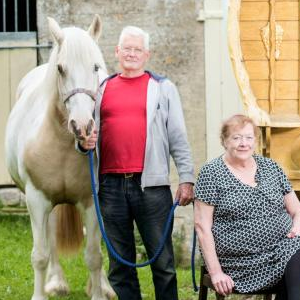
From Stargroves to Mill Hill farm
Their first winter was spent at Stargroves in Berkshire, an estate belonging to Mick Jagger (sold to him by John Michell), where Mark Palmer had to be medically treated, malnourished as he was from living an unbalanced macrobiotic life. He first refused to see a doctor though, as he was convinced his body was just getting rid of the poison of modern life. Like we told before, he was taking this trip through England and Wales as a real Arthurian quest.
Mark Palmer and friends wandered around the country for about four years, at an average speed of 4 miles a day. After having roamed around Wales, staying at places like Hay-On-Wye, Llandysul, Welshpool and Montgomery they went up further north to Wiseton (Doncaster) and Retford (Nottinghamshire).
Henrietta Moraes left the convoy after a couple of years to become Marianne Faithfull’s secretary. Mark Palmer finally settled on Mill Hill farm at Sherborne, Gloucestershire, where he specialised in the horse-breeding business.
Hippie or not that farm (and its surroundings) is now estimated at over 3 million pounds. Seems that he found that Holy Grail after all.
The Church wishes to thank Emma Peel Pants, Sophie Partridge.
♥ Libby
♥ Iggy ♥
Sources (other than the above mentioned links):
Artlark: The
Model-Mistress-Muse Paradigm: Henrietta Moraes, Artlark, 22 May 2019.
Beechey,
James: Henrietta
Garnett obituary, The Guardian, 19 September 2019.
Boyd, Joe: White
Bicycles, Serpent's Tail, London, 2009, p. 358 (eBook version).
Green,
Jonathon: Days In The Life, Pimlico, London, 1998, p. 216.
Higham,
Nick: Meet
the Author: Henrietta Garnett, BBC, 30 Augustus 2012.
Martin,
Douglas: John
Michell, Counterculture Author Who Cherished Idiosyncrasy, Dies at
76, New York Times, 2 May 2009.
Moraes, Henrietta: Henrietta,
Hamish Hamilton, London, 1994, p. 97, 101, 105, 108 - 109, 111.
Nicholson,
Virginia: HENRIETTA
GARNETT (1945-2019), Charleston, (no date).
Telegraph Obituaries: Henrietta
Garnett, scion of the Bloomsbury set who overcame a troubled childhood
to become an acclaimed biographer, The Telegraph, 20 September 2019
(paywalled).
Telegraph Obituaries: John
Michell, The Telegraph, 8 May 2009.
Williamson Marcus: John
Michell: Expert on ancient knowledge and pioneer of the New Age, The
Independent, 21 May 2009.
Young, Rob: Electric Eden: Unearthing
Britain’s Visionary Music, Faber And Faber, London, 2010 (ePub
version, chapter: The Inward Exodus, no page numbers).


